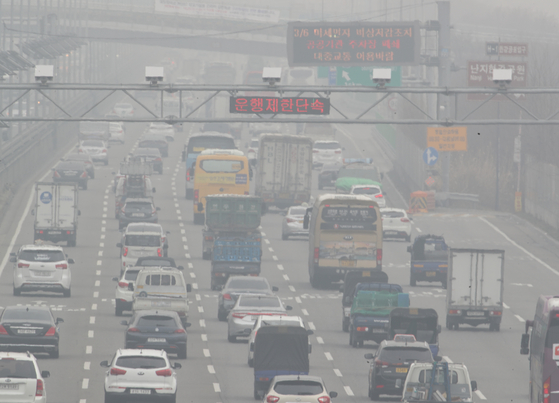When an old diesel vehicle with a lot of smoke is scrapped, the government subsidy limit is raised to 6 million won per vehicle. It is limited to livelihood vehicles owned by small business owners and low-income people, or with smoke reduction devices.
Additional subsidies for eco-friendly used cars in addition to new cars after scrapping

In the afternoon of March 2019, a notice board installed on the road toward Seoul near Gayang Bridge, Seoul, has a message indicating the crackdown on old diesel vehicles and restrictions on operation. yunhap news
On the 4th, the Ministry of Strategy and Finance and the Ministry of Environment announced that they would expand and reorganize the support for early scrapping of old diesel vehicles. Subsidies will be issued if the vehicle with a grade 5 exhaust gas with a gross weight of less than 3.5 tons is scrapped early. The subsidy from a maximum of 3 million won per vehicle will increase to a maximum of 6 million won from the 5th. The number of early scrapped old diesel vehicles that are subject to subsidies has increased from 300,000 last year to 340,000 this year.
In order to receive a subsidy of up to 6 million won, several conditions must be met. It must be a vehicle that cannot be equipped with a smoke reduction device at all, or it must be a vehicle for business, a small business owner, a basic living recipient, or a vehicle owned by the upper class.
It does not mean that all subsidies are given up to the limit at once. When disposing of old diesel vehicles early, subsidies equivalent to 70% of the car price can be received up to 4.2 million won (70% of the subsidy limit). If you get rid of old diesel cars and buy a used car with less toxic gas emissions (emissions 1 and 2 class) like new cars or electric, hydrogen, hybrid, gasoline, and liquefied natural gas (LPG) vehicles, you can get up to 1.8 million won (30% of the subsidy limit). Add more. Previously, the remaining 30% subsidy was provided only when buying a new car, not a diesel car, but a used car was added due to a change in regulations.
An official from the Ministry of Technology said, “In consideration of the fact that most of the old diesel car owners prefer to purchase used cars after scrapping, as most of the low-income people, we decided to pay subsidy (additional subsidy) for the purchase of used cars corresponding to emission levels 1 and 2. The reorganization of the subsidy system is expected to reduce the repurchase rate of diesel vehicles and increase the effect of improving the atmospheric environment.”
For ordinary old diesel vehicles that are not a livelihood type, the subsidy limit (3 million won) is the same as before. Again, 70% (up to 2.1 million won) is paid when scrapped cars, and 30% (up to 900,000 won) is divided into new cars or used cars of grade 1 and 2 emissions.
Early car scrapping support project plans for each local government nationwide will be announced from the 5th. The support project procedure is handled by the Korea Automobile Environment Association. You can check whether your vehicle is eligible for subsidies by visiting the Ministry of Environment’s automobile emission rating system (emissiongrade.mecar.or.kr). You can apply online by visiting this site. You can also apply by mail or fax to the Korea Automobile Environment Association. For detailed information, please refer to each local government notice or call (1577-7121).
Old diesel vehicles that are subject to scrapped vehicle support refer to vehicles with an emission of nitrogen oxides and hydrocarbons of 0.560g per kilometer (driving distance) and an emission of particulate matters of 0.050g or more. This standard was only allowed before July 2002. During the seasonal fine dust management period, if a vehicle with a class 5 exhaust gas operates in the metropolitan area from 6 am to 9 am on weekdays, a penalty of 100,000 won per day is imposed.
According to the Ministry of Environment, 38172 vehicles were detected in the crackdown on restrictions on operation of vehicles in the metropolitan area from December 1st last year to 31st last month. Of these, 29,247 cars were fined for negligence. The remaining 8,925 vehicles were scrapped, fitted with exhaust reduction devices, and applied for low pollution measures.
Sejong = Reporter Cho Hyun-sook [email protected]
